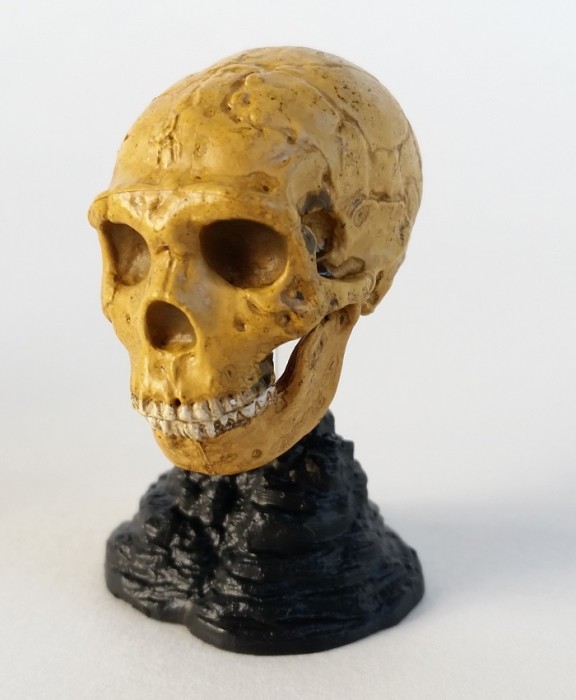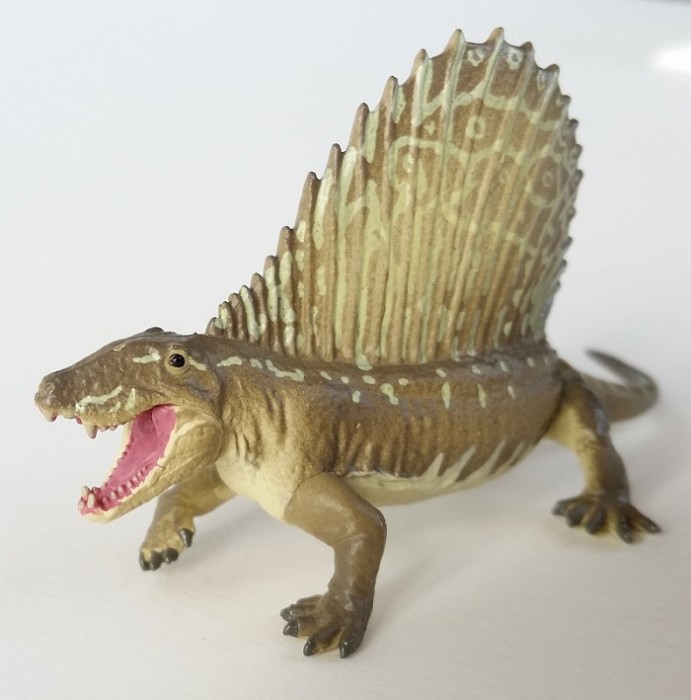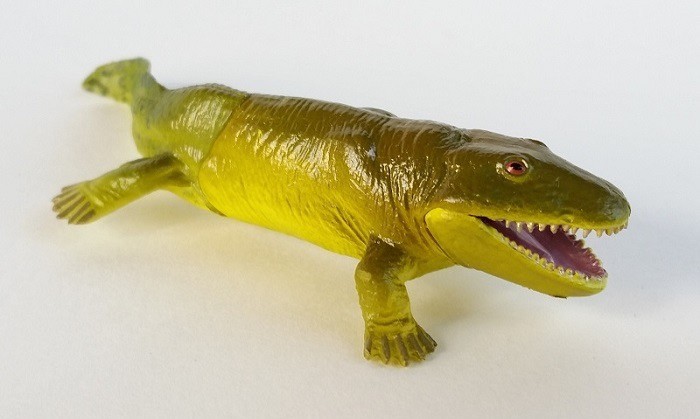Review and photographs by Tim Sosa
From July-October 2015, the National Museum of Nature and Science in Tokyo hosted an exhibit called “Leaps in Evolution: Tracing the Path of Vertebrate Evolution.” To commemorate the exhibit, Kaiyodo made a set of five vending machine capsule figures, most representing a stage in the evolution of vertebrates. Each of these can be tied to a “key innovation,” or an adaptation that enables a lineage to diversify at the expense of potential competitors, predators, or prey. Let’s take a look at the five figures, starting with our closest relative and going back through time.

First up is the skull of a Neanderthal Homo neanderthalensis, a species which lived until about 40,000 years ago, well after modern humans had started spreading outside of Africa, and may have interbred with them. This skull, showcasing the large braincase that is the hallmark of humans, is a fitting visual reminder of what makes us us. It’s well-made in about 1:10 scale and identifiable as H. neanderthalensis by the prominent brow ridges and large teeth, although in actual specimens the teeth are much less tidy, probably because of decay of the remains between death and fossilization.

We travel pretty far back in time to reach Dimetrodon limbatus, which lived in the early Permian period over 270 million years ago. Dimetrodon was a synapsid, an early member of a lineage whose only survivors are the mammals. Synapsids did a couple of interesting things that ended up being important for mammals. One, they reduced the role of the articular and quadrate bones in the jaw joint, which freed them up to later become part of our middle ear. And two, they evolved the ability to regulate their own body temperature metabolically. It isn’t clear when that occurred, but one hypothesis for the function of the sail of Dimetrodon is temperature regulation, so it makes sense that it would be included in this set. This is a big improvement on the Dimetrodon from Kaiyodo’s Dinotales line back in 2001, with excellent detail and a pose that reflects recent suggestions that their stance was somewhat more erect than previously thought. It’s about 1:45 if it represents a large specimen of D. limbatus.

Next up is Ichthyostega, an early tetrapod relative. Ichthyostega lived during the Devonian period, and was one of the first fishes to have well-developed limbs with digits, and could probably have walked around a little bit in addition to swimming. This figure is in about 1:12 scale and looks great, with the characteristic broad, flat head and tail still adapted for an aquatic lifestyle. When Ichthyostega was first discovered, everyone assumed it had five digits just like us, lizards, and the earliest dinosaurs. But later preparation of the fossils revealed that some of the earliest tetrapods, like Ichthyostega, had seven or even eight digits. Some of those wouldn’t have been obvious externally when covered with muscle and skin, and this Kaiyodo figure is therefore well within the range of possibility, showing six external toes. Nice work!

While Ichthyostega was learning to crawl, Dunkleosteus was the top predator in the world’s oceans. It was an arthrodire, a group that had already been around for tens of millions of years. Arthrodires were among the first vertebrates with jaws, which are not only great for eating things, but also became important for hearing for some vertebrates. This little ~1:40 scale skull replica features a hinged jaw, calling attention to its importance in the evolution of vertebrates.

Finally we reach Anomalocaris, a major predator of the Cambrian period, over 500 million years ago. This is the only figure in the set that isn’t a vertebrate, and in fact the only one that isn’t relatively close to a direct ancestor of humans. Maybe that’s because at the time of Anomalocaris, our ancestors were essentially jawless, spineless little worms with a gill basket, which would look a little less awesome as toys. So Kaiyodo went with Anomalocaris, an arthropod distantly related to insects, spiders, and barnacles. Anomalocaris probably ate our distant relations for breakfast! It was part of the so-called “Cambrian Explosion,” a sudden (by geological standards) profusion of life that evolved in the world’s seas and set the stage for major lineages of animals, such as arthropods, mollusks, vertebrates, and echinoderms. This figure is similar to the one Kaiyodo made for their Dinotales line, but more finely detailed, a fitting homage to this extremely important time in Earth’s history. Like the Dinotales version, it’s about 1:10-1:15 scale.

Overall, this set is a fantastic miniature review of evolutionary history (biased a bit toward our own ancestors). The exhibit in Tokyo has ended, but a fair number of these seem to have found their way to the secondary market, so you might be able to find them through web sites such as eBay or through a friend with a connection in Japan. They’re already fetching fairly high prices, so if you want them, sooner is better than later!
Disclaimer: links to Ebay and Amazon on the DinoToyBlog are affiliate links, so we make a small commission if you use them. Thanks for supporting us!




really nice